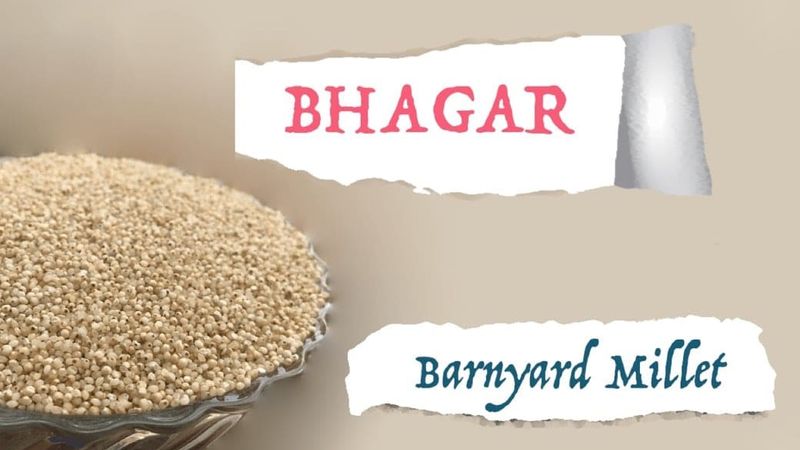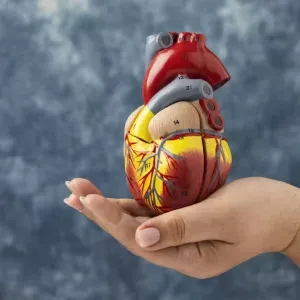

Our Review Process
Our articles undergo extensive medical review by board-certified practitioners to confirm that all factual inferences with respect to medical conditions, symptoms, treatments, and protocols are legitimate, canonical, and adhere to current guidelines and the latest discoveries. Read more.
Our Editorial Team
Shifa Fatima, MSc.
Author
Dr. Apoorva T, MHM.
MEDICAL ADVISOR
Is Samak Rice (Bhagar) Good for Diabetics?
Bhagar is also called Variche Tandul and is consumed during fasts in Maharashtra. This dish is spicy or can be sweet and is essentially gluten-free, and it may be served as a side dish on any given day. This whole grain has been grown in the southern and western Indian states in paddy fields for thousands of years.
Apart from being called Sama ke Chawal, Bhagar has other names too. It is known as Moriyo in Gujarat and Varicha Bhat or Varyache Tandul in Maharashtra. The other names are mordhan, samak, samvat, varai, or vari. The names vary from region to region and from language to language. In this blog we are going to discuss about is bhagar good for diabetics? Also know about freedom from diabetes
Table of Contents
Can Diabetics Eat Bhagar?
Diabetes is a condition in which the body is unable to utilise insulin properly or produce enough insulin to meet the body's needs. As a result, the body finds it difficult to metabolise food for energy. This increases the blood sugar or blood glucose level, which becomes complicated and dangerous if not treated. People suffering from diabetes are not allowed to eat sugar or any form of carbohydrates. Know about diabetes treatment in pregnancy.
People with diabetes have to be cautious while consuming carbohydrates, yet good carbs, especially complex carbs, can be useful in managing diabetes. Bhagar, also known as Sama rice, is a whole grain that contains high fibre, vitamins, and minerals. This should be a part of the diet for people suffering from diabetes.
Also know is ragi good for diabetes.
What Is The Glycemic Index of Bhagar?
Bhagar offers several health benefits. This wholesome grain has low calories and a low glycemic index. It is made from barnyard millet and is an ideal food for people who have cardiovascular disease and diabetes. Additionally, Bhagar being easy to digest reduces bloating of the belly. It is known to prevent constipation as well as stomach cramps and is a healthier substitute for white rice.
The Low glycemic index of the grain offers several benefits making it an ideal food for people who have cardiovascular disease and diabetes.
- Overall Glycemic Index : 55 (Low)
- Dehulled Grains : 50 (Low)
- Heat Treated Grain : 41.7 (Low)
How Many Calories Does Samak Rice Have?
Samak rice having a serving size of 100 g will have 163 calories. Since samak rice is fiber-rich, gluten-rich, and highly nutritious, it can be eaten by anyone willing to maintain a healthy weight or control blood sugar levels. If you were wondering ‘is samak rice good for weight loss,’ we’d say yes. However, consume it in moderate quantities as an excess of any food item can be harmful. Read more to know about what level of blood sugar is dangerous?

What Are The Health Benefits of Samak Rice?
Also known as Barnyard millet, sama grains, sama seeds, etc., this ancient millet is cultivated in countries like India, Korea, and Japan. Botanically, they are wild seeds that are tiny and cream-colored, round grains cooked widely during the fasting season. Its texture is similar to semolina, and its grain size is smaller than rice. Since samak rice is loaded with protein, fiber, and essential micronutrients like iron and zinc, it provides numerous health benefits. Some top samak rice benefits are listed below:
Helps Maintain Healthy Blood Sugar (Glucose) Levels
Samak rice has an average concentration of carbohydrates compared to other millets. It is also more rich in fiber than most cereals. This unique composition makes samak rice useful in blood sugar maintenance, eventually helping people with diabetes control their condition.
Helps Lower Cholesterol Levels
This rice contains a high composition of resistant starch. According to numerous research studies, resistant starch helps lower body inflammation by acting as fiber. It improves gut bacteria health and reduces the amount of bad cholesterol or LDL in the body. However, you can enjoy its full benefits when consumed at moderate levels.
Helps Prevent the Risk of Anaemia
Anaemia deficiency is a widespread health problem found mostly in women across the globe. Since samak rice is rich in iron, regular consumption (in moderation) can help overcome iron deficiency, thereby controlling anemia symptoms. Samak rice has approximately 16 mg/100g iron content, which is a good amount to fulfill the iron deficiency in the human body. Besides fulfilling the minimum body requirement of iron, samak rice also helps improve other body functions, like maintaining respiratory health and regulating body temperature. Also know about Indian diabetes diet.
Prevents Digestive Problems
If you get constipation-related problems or digestive diseases quite frequently, regular consumption of samak rice can help. Be it bloating, stomach pain, flatulence, or bad digestion, samak rice can help control these problems.
Helps in the Proper Absorption of Body Nutrients
Some food items are high in phytic acid, an anti-nutrient that naturally develops in plants. If you consume food with a high phytic acid content, your body will have trouble absorbing certain nutrients like magnesium and calcium. Fortunately, samak rice is low in phytic acid, so it doesn’t hinder nutrient absorption. Compared to other food items like regular rice, whole wheat, etc., samak rice aids in greater absorption of calcium, magnesium, and other essential nutrients in the body.
Helps In The Growth and Development Of Body Cells
Protein is needed for the healthy growth, development, and repair of body cells. Samak rice has a significantly higher percentage of protein than other cereals and millet, making it a desirable source of protein. You can find approximately 11.2 % to 12.7% of the protein in samak rice, which is considered good. If you include samak rice in your daily diet over regular rice, you can have better muscle mass development, and the body will be in a better position to maintain good health.
In addition to these benefits, samak rice helps people with celiac disease. Samak rice has low calories and is gluten-free, so having it doesn’t trigger an immune reaction, leading to damage in the small intestine lining. Even minor damage to your small intestine lining can lead to severe health complications. So if you cannot exclude regular rice entirely from your diabetes diet, consider replacing it with samak rice to get the best health benefits.
What Is Bhagar Nutritional Value?
If you plan to include bhagar in your diabetes-friendly diet, being aware of its nutritional profile will help. You can learn more about bhagar nutritional value from the chart shared below:
| Nutritional Value of 1 Cup of Cooked Bhagar (% Daily Value is Based on a 2,000 Calorie Diet) | |||
|---|---|---|---|
| Protein | 22.9 g | Fat | 28.4 g |
| Carbs | 78.2 g | Saturated | 13.8 g |
| Sugar | 19.8 g | Trans | - |
| Dietary Fiber | 8.2 g | Polyunsaturated | 2.0 g |
| Sodium | 168 mg | Monounsaturated | 6.4 g |
| Potassium | 756.6 mg | Vitamin A | 131.4% |
| Cholesterol | 47.4 mg | Vitamin C | 258.2% |
| Calcium | 33.2% | Iron | 31.5% |
If you want to know the total number of bhagar calories present in one full cup of bhagar, the answer is 515 calories. Of these 515 calories, 47% (78.2 g) is carbs, 14% (22.9 g) is protein, and 39% (28.4 g) is fat. To burn all these calories, you may have to resort to 52 minutes of running, 1.3 hours of cycling, or 3.1 hours of house cleaning.
Is Samak Rice Good For Weight Loss?
Yes, samak rice is good for weight loss. Since it is protein-rich, high in fiber, gluten-free, and low in calories, samak rice can help you in your weight loss journey if you eat it over a sustained period. The low caloric density and presence of highly digestible protein make it easier for your stomach to digest samak rice while ensuring you get full nourishment from it, resulting in high energy levels. Another reason why samak rice helps in weight loss is by preventing frequent hunger pangs. Since samak rice is high in resistant starch, your stomach takes time to digest it. You also feel fuller for longer, and the desire to eat frequent meals diminishes.
Read about other options for sugar free sweeteners
What Is The Nutrient Content In Bhagar?
Yes. Bhagar is good for diabetes. The daily calorie requirement of an adult is 2000 calories out of which 12% of the requirement can be supplied by a single serving of Bhagar or Sama rice.
It is a food loved and well known in India and contains nutrients such as amino acids, calcium, phosphorus, and potassium. It is eaten in boiled form, which helps to retain healthy nutrients. It's a healthy dish because it is rich in dietary fibre and other nutrients, such as carbohydrates and proteins.
Health Benefits Of Bhagar For Diabetics
Bhagar is good for diabetes as it is full of fibre and nutrition. The sama rice is prepared in the same manner as broken brown rice. Eating sama rice curbs the desire to eat rice and is a great and vital source of energy. Rich in fibre, it stabilises the digestion process in your stomach and intestines and thus helps restrict the entry of sugar into the bloodstream. Consequently, this reduces the possibility of a blood sugar spike.
Once consumed, it gives you a feeling of contentment, and your belly feels full. One doesn't feel like eating once Bhagar has been consumed. Bhangar being rich in fibre is ideal for losing weight. If consumed in the right proportion and quantity, the body will be able to digest it and help maintain a healthy weight.
Cooking Bhagar for Diabetes
Bhagar for diabetes is cooked in water, the way rice is cooked. One can boil the grain as well with milk and sugar to make a sweet rice dish. Some prefer to cook the bhagar grain with Indian spices to make it tasty. The preparation of the rice depends on individual liking. However, one has to be cautious while preparing Sama rice. It is advisable not to consume Bhagar with potatoes, as potatoes are not healthy for people who have diabetes. Skipping potatoes from the recipe is recommended even for people suffering from heart problems, and it is good for weight loss. Also, you must eat Sama rice in appropriate quantities.
Bottomline
Bhagar for diabetes is very helpful. It has a high nutritional value and is high in fibre. It is beneficial to digestion and can even be consumed by people with diabetes, although they must exercise caution. The glycemic index of bhagar is low. You must avoid using potatoes and other ingredients when making Sama rice to limit carb intake. It is also advisable to consult your doctor before consuming bhagar. Also know about fasting blood sugar level.
FAQs
Is samak rice good for diabetics?
Bhagar is gluten-free and is healthier than white rice. It is light and easy to digest. Bhagar glycemic index is low. Thus, bhagar is good for person with diabetes and also for individuals with coexisting heart diseases.
What is Bhagar made of?
Bhagar is grain obtained from the grass that grows in and around a rice paddy field. Farmers do not remove the grass, but instead harvest it to produce bhagar grains.
Is Bhagar rich in Protein?
Bhagar is a wholesome food that is rich in micronutrients and proteins and acts as an antioxidant. One serving of bhagar has 13% of the daily recommended protein intake (22 gm).
Is Bhagar a Grain?
Bhagar is a grain. It originates from the millet family and is grown along with paddy fields.
Is Bbhagar Gluten-free?
Gluten is a kind of protein. Bhagar, on the other hand, is gluten-free, making it an excellent choice for people with diabetes. It also aids in the control of blood sugar levels.
Is Bhagar Good for Diet?
Yes, bhagar is good for diet. This low-calorie wholesome grain has a low GI and offers numerous health benefits. It is especially excellent for people with diabetes and cardiovascular problems. Since it is easy to digest and makes you feel fuller for a long, you can notice visible results by including bhagar in your diet plan.
Does Bhagar Increase Sugar?
No, bhagar does not increase sugar levels if eaten in moderate amounts. Bhagar has a low GI, so people with prediabetes or diabetes can easily include it in their diabetes-friendly diet. This nutritious rice is healthier than regular white rice and is also gluten-free. Whether you want to maintain healthy blood sugar levels or get help with managing coexisting heart diseases, bhagar can help. Also know about prediabetes diet.
Disclaimer
This website's content is provided only for educational reasons and is not meant to be a replacement for professional medical advice. Due to individual differences, the reader should contact their physician to decide whether the material is applicable to their case.








